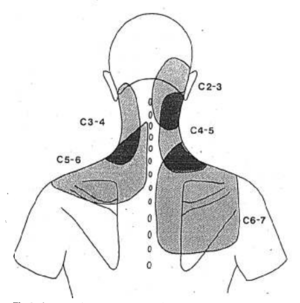Cervical Spine Pain Definitions
Cervical somatic pain, cervical radicular pain, and cervical radiculopathy all have different meanings. It is vital that the distinction in meaning is understood. Confusion often arises because both neck pain and cervical radicular pain are caused by disorders of the cervical spine. Other than the common site of disease, the conditions are completely different.
Cervical Spine Pain
This can be further divided into
- Suboccipital pain - between superior nuchal line and C2
- Upper cervical pain - above transverse line through C4
- Lower cervical pain - below C4
This definition recognises that musculoskeletal causes of neck pain are typically perceived posteriorly. Musculoskeletal causes of anterior neck pain are uncommon, and little has been published about this phenomenon. If a patient complains of anterior neck pain it should be differentiated from visceral causes such as pain from the lymph nodes, pharynx, larynx, trachea, or oesophagus. The anterior neck is divided into the triangles of the neck.
Bogduk emphasises that cervical spinal pain is perceived posteriorly He states that pain in the region of the anterior cervical spine is called throat pain and there is a lack of any definition by an international authority. He further states that practitioners wanting to use the term "anterior neck pain" need to prove that it is coming from the cervical spine.[2] He does not provide any references for these claims. In the editor's opinion, the claims are wrong.
- In a study of symptom mapping with provocative discography, anterior neck pain occurred in 20% (2/10) for C2-3, 21% (4/19) for C2-3, 15% (4/27) for C4-5, 15% (4/27) for C5-6, and 13% (2/16) for C6-7.[3]
- The term "neck lump" usually refers to pain in the anterior neck - throat lump has a completely different meaning, and refers to a lump in the pharynx.
- The anterior neck is divided into the "triangles of the neck," not "triangles of the throat."
- What Bogduk calls "throat pain" is commonly used to mean pain in the oropharynx, and is not usually used to refer to pain in the anterior or posterior triangles of the neck.
- With regards to proof of causation, he provides no justification as to why such a higher standard of evidence be required for anterior neck pain than posterior neck pain. To use his own argument for posterior neck pain, anterior neck pain simply references a location, not the cause of the pain. Furthermore, "anterior neck pain" does not include the term "cervical spine."
Timing of pain
- Acute pain: Pain <3 months
- Chronic pain: Pain > 3 months
Cervical Radicular Pain
Cervical spine pain and cervical radicular pain are two completely different entities. They have difference causes, and different evidence base for diagnosis and management.
Cervical radicular pain is a symptom. It is lancinating, shooting "electric" pain that travels down a limb in a narrow band. It is due to stretching of an already inflamed nerve root. The pain may be momentary. It usually co-exists with cervical somatic and somatic referred pain. There are typical referral patterns (dynatomal, not dermatomal), however many patients will not have a distinct referral pattern.[4]
Cervical radicular pain is also not the same thing as radiculopathy. Cervical radiculopathy refers to signs elicited on examination: weakness, loss of reflexes, loss of sensation, and/or muscle wasting. It is due to nerve root compression, and can be present in the absence of pain.
Somatic Referred Pain
- See also: Cervical Pain Maps, Somatic Referred Pain

The mechanisms is convergence. Sources in the cervical spine can have pain referred to the head, upper limb, interscapular region, and anterior chest wall. Headaches occur after noxious stimulation of C2-3 zygapophyseal joints, lateral atlanto-axial joints, and atlantooccipital joints. The following descriptors are used for regions of referred pain.
Scapular Pain: Pain perceived as arising substantially within the area encompassed by the borders of the scapula.
Upper Scapular Pain: Pain perceived as arising substantially within a region bounded medially by an imaginary line in a parasagittal plane coincident with the medial border of the scapula, laterally by the glenohumeral joint, superiorly by the upper border of trapezius, and inferiorly by the spine of the scapula.
Lower Scapular Pain: Pain perceived as arising substantially within the area encompassed by the borders of the scapula but below its spine.
Shoulder Pain: Pain focused over the top of the glenohumeral joint, centred over the lateral margin of the acromion.
Anterior Shoulder Pain: Pain focused over the anterior fibres of the deltoid muscle. Posterior Shoulder Pain: Pain focused over the posterior fibers of the deltoid muscle.
Posterior Shoulder Pain: Pain focused over the posterior fibers of the deltoid muscl
Referred pain in the upper limb can be qualified according to the topographic segment encompassed using standard anatomical definitions, viz., arm, forearm, hand, digits I-V, medial, lateral, anterior, posterior, ulnar, radial, etc.
Referred pain to the thoracic wall may be focused over the anterior, lateral, or posterior chest wall and should be described in such terms. Its exact topographic location can be specified by enunciating the ribs that it spans.
References
- ↑ 1.0 1.1 1.2 1.3 IASP. Classification of Chronic Pain
- ↑ Bogduk, Nikolai, and Brian McGuirk. Management of acute and chronic neck pain : an evidence-based approach. Edinburgh New York: Elsevier, 2006.
- ↑ Slipman CW, Plastaras C, Patel R, Isaac Z, Chow D, Garvan C, Pauza K, Furman M. Provocative cervical discography symptom mapping. Spine J. 2005 Jul-Aug;5(4):381-8. doi: 10.1016/j.spinee.2004.11.012. PMID: 15996607.
- ↑ Slipman CW, Plastaras CT, Palmitier RA, Huston CW, Sterenfeld EB. Symptom provocation of fluoroscopically guided cervical nerve root stimulation. Are dynatomal maps identical to dermatomal maps? Spine (Phila Pa 1976). 1998 Oct 15;23(20):2235-42. doi: 10.1097/00007632-199810150-00019. PMID: 9802168.
- ↑ Dwyer et al.. Cervical zygapophyseal joint pain patterns. I: A study in normal volunteers. Spine 1990. 15:453-7. PMID: 2402682. DOI.

